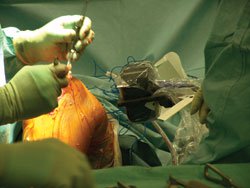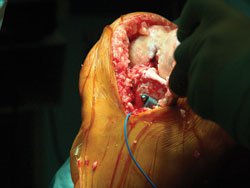Similar alignment seen with conventional, navigated TKA
One of the first randomized clinical trials to compare conventional total knee arthroplasty with procedures using electromagnetic navigation revealed no significant differences between groups regarding clinical outcomes.
“On the basis of these results, we think that proving cost-effectiveness for navigation in [total knee arthroplasty] TKA surgery remains a challenge,” Mark Blyth, FRCS, said during his presentation at the 12th EFORT Congress 2011.
For their study, Blyth and colleagues randomized 200 patients to undergo either electromagnetic-navigated or conventional TKA. Patients in the navigated group had procedures using the iNav electromagnetic navigation system (Medtronic; Minneapolis, Minn.).
|
Images: Blyth M |
“The iNav electromagnetic system is an imageless system developed at Medtronic in collaboration with Zimmer, which is now dissolved, and the system is no longer available in the marketplace,” Blyth said.
He described the device, saying that because it has no stereographic infrared cameras or reflective balls, “there are no line of sight issues, and no contamination of the reflectors is possible.” Blyth warned against using ferrous instruments such as saws, hammers or drills around electromagnetic navigation because the instruments may block the system and cause it to go blind or deflect the signal, causing inaccuracies.
Short-term results
The team collected data on both cohorts postoperatively at 3 months and 12 months. They assessed patients’ Oxford knee scores, American Knee Society scores (AKSS) and range of motion, and determined alignment using postoperative CT scans.
The investigators found a statistically significant difference between the groups regarding the AKSS scores at 3-month follow-up with the electromagnetic cohort showing superior results. However, they discovered no significant differences between the groups for AKSS scores at 12-month follow-up. In addition, there was no statistically significant difference found in range of motion between the groups at 3 months and 12 months.
|
|
“There was a significant improvement in extension by 12 months in both groups compared with preoperative scores, but that’s not exactly surprising after TKA surgery,” Blyth said.
Alignment measurements
There was no statistically significant difference between the groups for mechanical alignment, with 91% of the electromagnetic group measuring within 3° of neutral and 84% of the conventional group falling within 3° of neutral. In both groups, the distal femoral and tibial AP angles were within 3° of alignment.
Blyth and his team found no significant difference in distal femoral sagittal angle or tibial slope between the groups.
Blyth pointed out that “7° is the target for tibial slope” with the NexGen LPS Flex implant (Zimmer, Warsaw, Ind.) the team used for the conventional TKA group. But this figure was not reached routinely in either group. — Renee Blisard
Reference:
- Blyth M, Jones B, Smith J, Rowe P. Electromagnetic navigation versus conventional total knee arthroplasty: Clinical improvements. Paper 3217. Presented at the 12th EFORT Congress 2011. June 1-4. Copenhagen.

- Mark Blyth, FRCS, can be reached at Department of Trauma and Orthopaedics, Glasgow Royal Infirmary, 84 Castle Street, Glasgow G4 0SF, UK; 0141 211 4000; email: mark.blyth@ggc.scot.nhs.uk.
- Disclosure: Blyth is a consultant for and received grants for the study from Zimmer.
This well-designed randomized controlled trial confirms the accuracy of computer navigation in TKA, even with electromagnetic (EM) tracking systems. The deficiencies of the optical navigation systems, due to line of sight, are overcome. Unfortunately the EM trackers are affected by metal, and special instruments are needed. Despite these new challenges, the accuracy of the EM navigation seems to be comparable to the optical navigation. In this trial, the mechanical axis and the sagittal femoral axis were more accurate with EM navigation than with a conventional technique. However, the functional outcome was similar at 12 months. This raises the question whether mechanical alignment is the right target when aiming for an improved functional outcome. On the other hand, the mechanical axis might be important in the long term to prevent wear and loosening of the implant. The navigation systems do hit the target, but if the surgeon chooses the wrong target, the improved accuracy is in vain. Also, the frequency of complications and short-term revisions, cost, and the extra time consumption must be evaluated to give a complete overview of this new technique.
— Øystein Gothesen, MD
University
of Bergen
Bergen, Norway
Disclosure: Gothesen has no relevant
financial disclosures.



